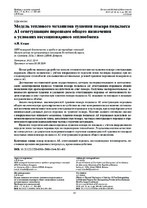| dc.contributor.author | Кицак, А. И. | |
| dc.coverage.spatial | Минск | ru |
| dc.date.accessioned | 2020-01-08T12:01:59Z | |
| dc.date.available | 2020-01-08T12:01:59Z | |
| dc.date.issued | 2019 | |
| dc.identifier.citation | Кицак, А. И. Модель теплового механизма тушения пожара подкласса А1 огнетушащим порошком общего назначения в условиях нестационарного теплообмена = Model of Thermal Mechanism of Subclass A1 Fire Extinguishing with General Purpose Fire Extinguishing Powder in Non-Stationary Heat Exchange Conditions / А. И. Кицак // Приборы и методы измерений : научно-технический журнал. – 2019. – Т. 10, № 4. – С. 391-401. | ru |
| dc.identifier.uri | https://rep.bntu.by/handle/data/62303 | |
| dc.description.abstract | Целью работы являлась разработка модели теплового механизма тушения пожара огнетушащим порошком общего назначения с учётом инерционности передачи тепла частицам порошка при нестационарном теплообмене для выявления оптимальных условий тушения порошками пожаров подкласса А1. Достижение поставленной цели осуществлялось методом экспериментального и математического моделирования процесса тушения пожара подкласса А1 огнетушащим порошком общего назначения при кратковременном воздействии на очаг пожара. Получены экспериментальные зависимости времени тушения и удельного расхода огнетушащего порошка от интенсивности подачи порошка в зону горения при тушении пожара подкласса А1 локально по площади и локально в ограниченном объёме. Анализ полученных закономерностей тушения пожара подкласса А1 огнетушащим порошком общего назначения при кратковременном воздействии на очаг возгорания показал наличие оптимальной величины интенсивности подачи огнетушащего порошка в зону пожара, при которой реализуется минимальный удельный расход порошка на тушение пожара. Наличие данного оптимума связано с инерционностью теплового механизма тушения пожара подкласса А1 порошками вследствие конечности времени передачи тепла, запасённого при пожаре, частицам огнетушащего порошка и ограниченности времени взаимодействия частиц с горючим материалом. Проведён теоретический анализ процесса тушения пожара по площади с учётом инерционности передачи тепла частицам порошка при нестационарном теплообмене. Результаты анализа качественно согласуются с результатами экспериментального изучения закономерностей тушения по площади модельных очагов пожара подкласса А1 огнетушащим порошком общего назначения. | ru |
| dc.language.iso | ru | ru |
| dc.publisher | БНТУ | ru |
| dc.title | Модель теплового механизма тушения пожара подкласса А1 огнетушащим порошком общего назначения в условиях нестационарного теплообмена | ru |
| dc.title.alternative | Model of Thermal Mechanism of Subclass A1 Fire Extinguishing with General Purpose Fire Extinguishing Powder in Non-Stationary Heat Exchange Conditions | ru |
| dc.type | Article | ru |
| dc.identifier.doi | 10.21122/2220-9506-2019-10-4-391-401 | |
| local.description.annotation | The aim of the paper was to develop a model of thermal extinguishing mechanism using dry chemical powder taking into account the inertia of heat transfer to powder particles during unsteady heat exchange to identify the optimal conditions for extinguishing of A1 class fires with powders. The method of experimental and mathematical modelling of fire extinguishing process using dry chemical powder with short-term effect on the fire was used to achieve the goal. The experimental dependences of the extinguishing time and unit consumption of the extinguishing powder on the intensity of the powder supply to the combustion zone in extinguishing of subclass A1 fire in same area and in a limited volume were obtained. The mathematical model of a thermal extinguishing mechanism using dry chemical powder has been developed, taking into account the inertia of heat transfer to powder particles during unsteady heat exchange. Analysis of the regularities of extinguishing the subclass A1 fire using powder with a short feeding it into the fire indicates the presence of optimum values of unity consumption of powder on the fire from the intensity of feeding it into the fire. The presence of this optimum is due to the inertia of extinguishing the subclass A1 fire using powder due to the finiteness of the heat transfer time to the particles of the extinguishing powder and the limited time of interaction of particles with the combustible material. The theoretical analysis of the fire extinguishing process over the area taking into account the inertia of heat transfer to the powder particles at non-stationary heat exchange are carried out. The results of the analysis are in qualitative agreement with the results of the experimental study of the regularities of extinguishing of model fire foci of subclass A1 with General-purpose fire extinguishing powder. | ru |

